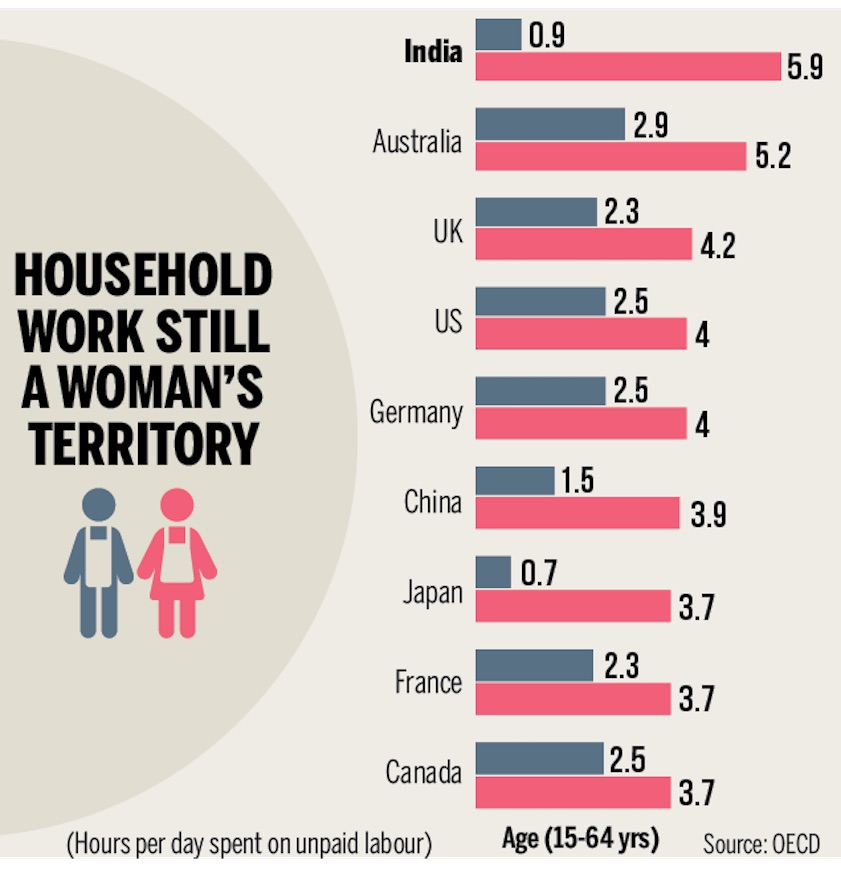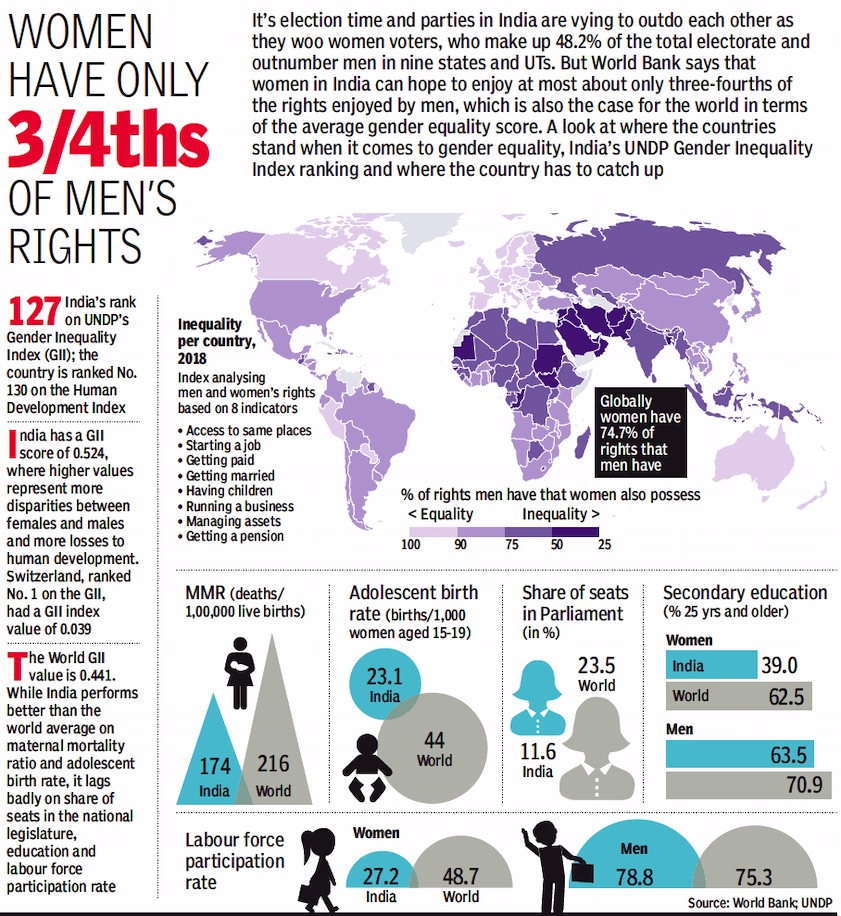Gender equality: India
This is a collection of articles archived for the excellence of their content. |
Contents |
Unpaid labour/ household work
2017: India and other countries
Indian women do most household work, while men do very little, November 1, 2018: The Times of India

From: Indian women do most household work, while men do very little, November 1, 2018: The Times of India
See graphic:
India and other countries- the disparity between men and women spending time on household chores, presumably as in 2017
Indian women spend nearly six hours a day on household chores, apart from paid work, while men put in less than an hour on the unpaid labour. This work includes cooking, cleaning, taking care of children, and other activities that require a household to function. Most of such work is disproportionately shouldered by women across the globe. In Canada, though, the disparity between men and women spending time on household chores is the least. Here's a look:
Rights
… in India and the world: 2018

From: March 16, 2019: The Times of India
See graphic:
Women’s rights in India and the world: 2018
Gender development/ gap indices
2019: India slightly better than neighbours
Ambika Pandit, Dec 10, 2019 Times of India
The Human Development Report 2019’s gender social norms index indicates that more than half the world’s people have a high intensity bias against gender equality and women’s empowerment with India actually seeing a backlash. The report also shows that India is only marginally better than the south Asian average on Gender Development Index (0.829 versus 0.828), and ranks at a low 122 of 162 countries on the 2018 Gender Inequality Index.
The data on various dimensions studied for arriving at India’s GDI for 2018 shows that life expectancy at birth for males was 68.2 and for females it was 70.7. Expected years of schooling in case of females was 12.9 and males it was 11.9. Mean years of schooling for males was 8.2 and for females it was 4.7. GNI per capita for females was Rs 2,625 and for males it was 10,712.
The report also puts out a Gender Inequality Index that reflects gender based inequalities in three dimensions - reproductive health, empowerment and economic activity. India has a GII value of 0.501, ranking it 122 out of 162 countries in the 2018 index.
2019: India slips 4 spots to 112
India has slipped four places to rank 112th globally in terms of gender gap amid widening disparity in terms of women’s health and survival and economic participation— the two areas where the country is now ranked in the bottom-fiveas per the an annual survey results shown on Tuesday.
While Iceland remains the world’s most gender-neutral country, India has moved down the ladder from its 108th position last year on the World Economic Forum’s Gender Gap Report to rank below countries like China (106th), Sri Lanka (102nd), Nepal (101st), Brazil (92nd), Indonesia (85th) and Bangladesh (50th). Yemen is ranked the worst (153rd), while Iraq is 152nd and Pakistan 151st.
Geneva-based World Economic Forum (WEF), an international organisation for public-private cooperation, said that this year’s improvement can largely be ascribed to a significant increase in the number of women participating in politics.
The political gender gap will take 95 years to close, compared to 107 years last year. Worldwide, women now hold 25.2% of parliamentary lower-house seats and 21.2 per cent of ministerial positions, compared to 24.1% and 19%, respectively last year.
However, the economic opportunity gap has worsened, widening to 257 years, compared to 202 years last year. The World Economic Forum had published its first gender gap report in 2006, when India was ranked relatively higher at 98th place.
Since then, India’s rank has worsened on three of four metrics, which are used for the overall ranking.
While India has improved to 18th place on political empowerment, it has slipped to 150th on health and survival, to 149th in terms of economic participation and opportunity and to 112th place for educational attainment. The WEF said economic opportunities for women are extremely limited in India (35.4%), Pakistan (32.7%), Yemen (27.3%), Syria (24.9%) and Iraq (22.7%). It also named India among countries with very low women representation on company boards (13.8%), while it was even worse in China (9.7%).
On health and survival, four large countries—Pakistan, India, Viet Nam and China— fare badly with millions of women there not getting the same access to health as men, the WEF said.
India ranks high on the political empowerment subindex, largely because the country was headed by a woman for 20 of the past 50 years. But, female political representation today is low as women make up only 14.4% of Parliament (122nd rank globally) and 23% of the cabinet (69th), the report said. PTI
2023
Ambika Pandit, June 22, 2023: The Times of India
New Delhi : India ranked 127 out of 146 countries in the Global Gender Gap Report 2023 released by the World Economic Forum showing an improvement of 1. 4 percentage points and eight positions from 135 in 2022. India has closed 64. 3% of the overall gender gap, the report said, marking a partial recovery towards India’s 2020 (66. 8%) parity level.
The index ranked India’s neighbours Bangladesh at 59, Bhutan at 103, China at 107, Sri Lanka at 115, Nepal at 116 and Pakistan at 142.
According to the report, while India has attained parity in enrolment across all levels of education ranking 26 on the sub-index with a score of 1 on a scale of 0-1, it has reached only 36. 7% parity on economic participation and opportunity. On the one hand, there are upticksin parity in wages and income but on the other, the shares of women in senior positions and technical roles have dropped slightly since the last edition.
The global gender gap score in 2023 for all 146 countries stands at 68. 4% reflecting an improvement of 0. 3 percentage points over 2022. For all countries covered, the health and survival gender gap has closed by 96%, the educational attainment gap by 95. 2%, economic participation and opportunity gap by 60. 1%, and political empowerment gap by a mere 22. 1%.
As far as political empowerment goes, India registered 25. 3% parity, with women representing 15. 1% of parliamentarians, the highest for the country since the inaugural 2006 edition. In terms of the share of women in ministerial positions, 75 countries have 20% or less female ministers. India, Turkey and China have less than 7% women ministers.
As of December 2022, 27. 9% of the global population, equivalent to 2. 12 billion people, live in countries with a female head of state. While this indicator experienced stagnation between 2013 and 2021, 2022 witnessed a significant increase. “This surge can be primarily attributed to India, the world’s most populous country, where a female President assumed power following the 2022 Presidential election. In total, since January 2022, nine women have come into power, with eight of them still holding their positions as of March 2023,” the report states.
It reflects on the significant strides made in terms of women’s representation in local government globally. Out of the 117 countries with available data since 2017, only 18 countries, including Bolivia (50. 4%), India (44. 4%) and France (42. 3%), have achieved representation of women of over 40% in local governance.